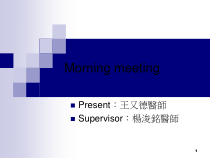 PPT
PPT
【文档说明】医学生物Present_课件.ppt,共(25)页,1.111 MB,由小橙橙上传
转载请保留链接:https://www.ichengzhen.cn/view-245538.html
以下为本文档部分文字说明:
Morningmeeting◼Present:王又德醫師◼Supervisor:楊浚銘醫師1Introduction◼Bowelobstruction,gastroenteritis◼Severepain,especiallyvisceralpain◼Severesyst
emicillness(myocardialinfarction,sepsis,orshock)◼Pregnancy(hormones)◼Increasedintracranialpressure(centralmechanism)◼Chemotherap
y(chemoreceptortriggerzone).23History◼Content◼Time◼Associatedsymptoms(fever,headache,abdominalpain..)◼Socialhist
ory(drugoralcoholabuse)◼Pastmedicalhistory(anyGIdisease,surgery)◼Medicationlist456Complication◼Hypovolemia◼Metabolicalkalo
sis◼Hypokalemia◼Mallory-Weisstearstypicallyfollowaforcefulboutofretchingandvomiting.Thelesionitselfisa1-to4-cmtearthroughthemucosaandsubmucosa;◼
Boerhaave'ssyndrome–--perforationofalllayersoftheesophagus--freepassageofesophagealcontentsintothemedia
stinumandthorax--80%ofcasesinvolvetheposterolateralaspectofthedistalesophagus--surgicalemergency.--Mortalityis50%ifsurgeryisnotperformedwi
thin24hours◼Aspirationofgastriccontents78Hiatalhernia9Introduction◼Frequentfindingbyradiologistsandgastroenterologists.10TypeI:Slidi
nghernia◼95%ofcases.◼Wideningofthemuscularhiataltunnelandcircumferentiallaxityofthephrenoesophagealmembrane→gastriccar
diatoherniateupward.◼Thephrenoesophagealmembraneremainsintact◼Posteriormediastinum111213TypeI:Slidinghernia◼Most
smallhiatalherniasareasymptomaticand,evenwithlargertypeIhernias◼Clinicalimplicationisthepropensitytodevelopgastroesophagealre
fluxdisease(GERD).◼Thelikelihoodofsymptomaticgastroesophagealrefluxincreaseswiththesizeofthehiatalhernia.14Othertypesofhiatalherni
a◼Lesscommontypesofhiatalhernia,typesII,III,andIV,arevarietiesof"paraesophageal"hernias→upto5%ofallhiatalhernias◼
Surgicaldissectionofthehiatusasoccursduringantirefluxprocedures,esophagomyotomy,orpartialgastrectomy.15Typ
eIIhernia◼Defectinthephrenoesophagealmembrane◼Gastroesophagealjunctionremainsfixedtothepreaorticfasciaandthemedianarcuateli
gament.◼Gastricfundusservesastheleadingpointofherniation1617TypeIIIhernias◼BothtypesIandII.18TypeIVhiatushernia◼Largedefectinthephrenoesopha
gealmembrane◼Allowingotherorgans,suchasthecolon,spleen,pancreas,andsmallintestine,toentertheherniasac.19Symptoms◼Epigast
ricorsubsternalpain◼Postprandialfullness,substernalfullness,◼Nausea,andretching.20Complication◼Gastricvolvulus→dysphagia◼Postcibalpain→gastr
ictorsion.◼Withintheincarceratedherniapouch→gastriculceration,gastritis,orerosions→Bleeding◼Respiratorycompli
cationsresultfrommechanicalcompressionofthelungbyalargeherniaorotherorgansherniatingthroughthehiatus.21Treatment◼Headofbedelevation◼Diet
arymodification◼Refrainingfromassumingasupinepositionaftermealsandavoidanceofmealsbeforebedtime◼Avoi
danceoftightfittinggarments◼Obesityisariskfactor◼Restrictionofalcoholuse22Medicaltreatment◼Antacids◼H2blocker◼PPI◼Pro
kineticdrugs23Surgicaltreatment◼Reductionoftheherniatedstomachintotheabdomen◼Herniotomy(excisionoftheherniasac)◼Herniorraphy(cl
osureofthehiataldefect)◼Anantirefluxprocedure◼Gastropexy(attachmentofthestomachsubdiaphragmaticallytopreventreh
erniation)24Thanksalot◼ReferencesfromUptodate25
 辽公网安备 21102102000191号
辽公网安备 21102102000191号
 营业执照
营业执照